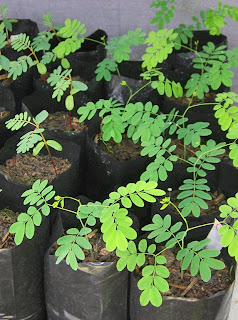The trees or bushes we chose are the result of a hard selection: the tree should show good qualities when used as windbreak, it must be available in Negros Island, thrive on clay-loamy soil and show at least one useful property like nitrogen fixer, erosion control, fruit, nut or food, bee or bird forage or food, resistance to dryness or water logging, good growth rate, mulching, medicine. Thanks to Negros Forests and Ecological Foundation, Inc. in Bacolod ( http://www.negrosforests.org ) especially to his Chairman Gerardo L. Ledesma and David "Davoy" Castor who helped me in the choice of species of trees and provided a great number of seedlings.

The first flower of a cutting of Hibiscus
in our nursery will be a component of
the living fence
We decided to install 7 rows:
- the first one is along the barbed wire and will establish a living fence supposed to replace the bamboo posts and the barbed wire when they will be destroyed in 3 to 5 years. Most percent of the plants are leguminous and will be used as forage for the lifestock. This row starts to deflect the wind.
- The second row is made with medium size trees (as neem tree), first real rampart to protect from the wind.
- The third row is the place of tall trees (as white lauan) which will deflect the wind high over the crops on about 10 times the height of the tallest tree.
- The forth row is again medium tree but exclusively fruit trees (as cachew or avocado).
- the 3 next rows are leguminous plants used for cut and carry method to feed the livestock.
Today we will see only the first row: the living fence. This row is the first you will see when you arrive at the school farm. It must be nice to see, that is why you will find Bougainvillea spectabilis so beautiful and much more efficient than barbed wire to keep bad people outside! And Tecoma stans, Duranta plumieri, Hibiscus rosa-sinensis and Caesalpinia pulcherrima will color and become more attractive the limit of the lot. A farm should also look like a garden!

Caesalpinia pulcherrima, a beautiful leguminous plant of Asia!
But it is also a farm and the living fence should also be productive and we will plant Cajanus cajan, the pidgeon pea, Calliandra calothyrsus, Sesbania sesban the egyptian pea and Gliricidia sepium the marvellous and multipurpose Madre de Cacao.
Let see the plantation of the 500 first Calliandra. The seedlings are planted every 50 cm to have a good windbreak effect. As always in a windbreak we give preference to the efficience as windbreak, not to the productivity. As rule of thumb, 500 Calliandra are enough to feed 1 cow or 4 to 5 goats.

Here the 9 steps:
Cleaning of the roots of sugar cane
 Sticking
Sticking Holing
Holing Adding compost
Adding compost
Mixing of the compost
 Planting
Planting Protecting from the wind
Protecting from the wind Spraying of microorganisms
Spraying of microorganisms Mulching with bagasse
Mulching with bagasse











